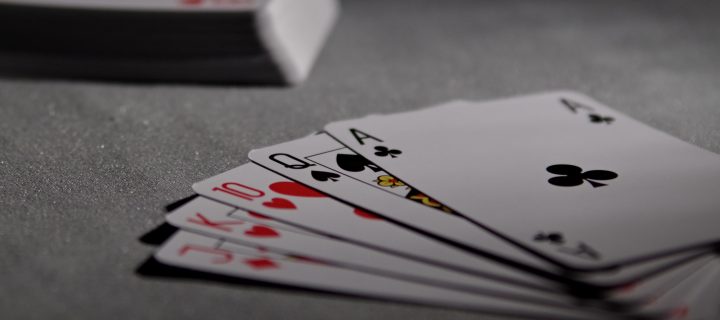The theme of this year’s Knutpunkt is shuffling the deck. With this theme, the organizers aim to rethink some of the ways in which the Nordic larp conference has traditionally been staged and perceived. Inspired by the theme we took on the challenge to rethink also the Knutpunkt / Knutepunkt / Knudepunkt / Solmukohta publication. This year the Knutpunkt companion is primarily an online publication, with pieces being published one by one from now until the week of Knutpunkt 2018.
The content has been divided into five sections named Hearts, Diamonds, Clubs, Spades, and Joker respectively. Under Hearts you will find designer and organizer reflections on specific larp productions. As Diamonds, you find larp designer and organiser tools and tips. As Clubs, we have collected tools and tips directed towards players. The Spades section contains articles that go broader and deeper in their analysis; these texts are also mostly academic. Finally, under Joker you will find the meta-discussions on the Nordic larp community – a community that today stretches around the globe and engages in a very wide range of larps.
Hearts
We are perhaps particularly happy about the Hearts section, where designers and organisers write about their passion and their struggles to realize their larp visions. These are all reflective pieces, written after the larp has successfully played out. Nina Teerilahti’s Freak Show: An Autopsy highlights how larp truly is an ephemeral art form, and how ephemerality can be embraced as the core of larp design. Two U.S. productions are covered: Immerton, a women-exclusive larp and the U.S. staging of Just a Little Lovin’ in August 2017. Shoshana Kessock writes about her personal struggle with re-telling and re-experiencing valued family traditions and memories in the form of a larp scenario, while Juhana Pettersson writes about larp at the grand scale, staged in the heart of European politics, the EU parliament. These pieces contribute with the ends of the scale, Kessock representing the small-scale and personal scenario design and Pettersson the grandiose and political, emphasizing how both are equally valid as artistic contributions.
Diamonds
On the other hand, we are equally amazed by the contributions to the Diamonds section. Juhana Pettersson present a tool for letting players co-create their characters, Maury Brown about larp mechanics for escalating and de-escalating play, and Daniel P. Espinosa about the benefits of using highly scripted interactions in a larp scenario. Simon James Pettitt looks upon how to design not just the larp but also the waiting time before the larp, in order to create a complete experience.
Several articles reflect how larp productions are increasingly being done professionally. Suus Mutsaers writes about how to make professionals and amateurs work together as a team, and Yaraslau I. Kot about the various elds in which larp design can be done professionally and where larp designers are sought-after professionals. Ashley Zdeb tells an amazing story about how to organise a larp as a band tour – or a band tour as a larp–and how in the end, it may not have been much of a difference.
Clubs
There are fewer Clubs in our deck, but that does not make them less valuable. Here, we have gathered articles that are primarily directed towards players rather than designers. Elin Dalstål presents some tips on how to play nasty or evil characters, something that many players nd overwhelming or scary. Susanne Vejdemo contributes to our understanding of “play to lose” by a discussion of what other players can do, to help each other play to lose. Finally, Susanne Vejdemo and Elli Garperian present a workshop which can be used by designers or organizers to let players learn to improvise larp rituals on the spot.
Spades
Under Spades, we find three more analytical texts. Sarah Lynne Bowman writes about the volatility of larp design, and how very small design decisions or random events can have profound e ects on how a larp plays out. Evan Torner moves away from larp into table-top RPG, to analyse some key play experiences that become relevant also in larp. Jesper Heebøll Arbjørn writes about how narratively oriented players contribute towards the larp narrative, and how their strategies can be incorporated into larp design striving specifically for narrative experience. The three contributions are closely aligned, as they all centre on the somewhat unpredictably co-creative nature of larp and on how to create slightly more predictable experiences while retaining player agency.
Joker
The final section of the book is perhaps the most important one: here we find reflections on the Nordic larp community and its emerging practices. Simon Brind and Martine Svanevik challenge the quest for safety, through interviewing multiple designers that have created larps that are intentionally challenging, one way or another. Jonaya Kemper writes about the opportunities and challenges that meet people of color when attempting to play and design larp. These articles both contribute to a lengthy and sometimes heated debate with carefully thought-through discussion pieces.
The Dealt Hand
With such a diverse collection of contributions, it is hard to find one common trend or theme. There are, however, some particular experiences and perspectives that shine through. One is how the old safety discussion takes a new turn this year, when Simon Brind and Martine Svanevik and the designers they interview challenge the quest for safety, asking us how we can at the same time play safe, and inspire reflection and change. Very similar issues are brought up by Aaron Vanek in his longer and online-only contribution to the KP companion. Contrasting with these two pieces is Maury Brown’s investigation of mechanics for escalation and de-escalation, designed precisely to encourage a culture of safety and trust. That these can be beneficial also in promoting self-inspection and change is illustrated by the accompanying designer re ection on Immerton. All of the authors have their points. What is clear is that this is a healthy discussion which leads to new and interesting design solutions; also, that the discussion is not likely to end anytime soon!
However, a more problematic trend also emerges in this year’s collection, related to who gets to realise their larp visions. Evan Torner and Nina Teerilahti both report how their productions met with intense online criticism even before realized, based on the risk that they would end up treating their themes with insufficient sensitivity and care. The designer team behind Immerton tell us in detail how they went about to avoid any online criticism. Here, we are not speaking about large-scale commercial productions. They were produced by volunteer teams driven by enthusiasm and emotionally ill-equipped for massive backlash, especially before the larp was staged and the teams were at the same time busy with organizational and design issues.
These particular productions were realised anyways due to dedicated and resourceful organizers, but they left the teams emotionally drained. But this type of online criticism can effectively jeopardize a production, should e.g. a venue owner become scared of the controversy. That this may happen is well illustrated by how the WorldCon organizers decided to cancel a larp scenario, when exposed as controversial (Stenros and Montola 2017).
As editors of this year’s companion, we would like to take the opportunity to call for action: the Nordic larp community must become better at protecting its artists and designers. They are our visionaries and our risk-takers; they will make mistakes and must be allowed to make them. To challenge an established designer for poor design choices and other actual mistakes is one thing, criticizing people for potential design mistakes they may make altogether another. Aiming to censor what themes a designer can address is particularly problematic, and more generally, reserving judgement until the larp has been played is a good idea. Furthermore, we must collectively step up to protect artists and designers against unfounded and hostile criticism. Save them some emotional energy. The latter is critical if we are to answer Jonaya Kemper’s call, and open up for marginalized groups to both play and design. A larp exclusive for people of color run the same risk as Immerton of an extensive wave of criticism, from groups that are very good at Internet harassment.
Raising the Stakes
We take it back. We are equally amazed by all contributions to this year’s Knutpunkt companion. Whether they are practical, reflective, critical or theoretical they all have in common that they allow us as a community; as larpers, organisers, and designers, to reflect and to grow.
We wish end this introduction by urging you to read, share, reflect on and talk about the articles being published here during the coming weeks. Maybe you’ll find a new idea, point of view or question to bring with you to Knutpunkt!
References
Jaakko Stenros and Markus Montola. How Worldcon Banned a Larp. Blog post, August 2017. https://jaakkostenros.wordpress.com/2017/08/13/how- worldcon-banned-a-larp/ (Accessed Jan 2018)
Acknowledgements
A book like this is not the sole work of anyone. The chapter authors, of course, deserve our first and deepest thanks; the enthusiasm, time, and enormous knowledge you put into the chapters humble us and dwarf our efforts.
Furthermore, we were not alone even in editing this volume. Each of the individual chapters have had an assigned editor, who had the main responsibility for giving comments and feedback to the author during the writing process. Most of the editors are part of the fabulous Nordiclarp.org crew. We are deeply grateful for the enthusiasm, energy and care you put into editing, Sarah Lynne Bowman, Mo Holkar, Evan Torner, and Suus Mutsaers. Special thanks go to Jaakko Stenros who does not usually edit for Nordiclarp.org, but who still kindly agreed to take on two chapters for this book. Without our co-editors this book would not have happened, period.
The book manuscript as such was put together over a few intense days in early January 2018. This would not have been possible without the precious Jon Back and Sofia Stenler, who helped with proofreading the articles and formatting them to be ready for typesetting. You gave us a full day of your precious vacation hours together – and we can’t thank you enough!
Finally, the beautiful card symbols used for the cover and section introductions were done by Mia Häggström for this year’s Knutpunkt.
(We are not sure what we did, except write the introduction. Only that it took a lot of time to do, whatever it was.)






